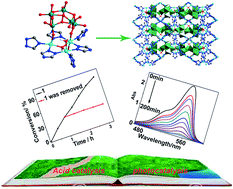Synthesis and properties of a POM-based trinuclear copper(ii) triazole framework†
Abstract
A novel POM-based trinuclear copper(II) triazole framework, namely, [H2{Cu6(trz)6(μ3-OH)2}Mo5O18]·3H2O (1) was isolated using a hydrothermal method, which displays a 3D network constructed from trinuclear copper(II) units and triazole ligands with [Mo5O18]6− anions as templates. 1 has been identified by single crystal X-ray diffraction, elemental analysis, thermogravimetric analysis, powder X-ray diffraction and FT-IR. Magnetic studies indicate that antiferromagnetic interactions exist in 1. In addition, 1 exhibits good Lewis acid catalytic activity for the synthesis of cyclohexanone ethylene ketal with 95% conversion. The HOMO–LUMO gap (Eg) of 1 is 2.34 eV calculated using the Kubelka–Munk equation (Fhν)0.5, indicating that its forbidden bandwidth belongs to the semiconductor category. Visible-light photodegradation of RhB catalyzed by 1 was investigated, which shows high activity with an above 98% degradation rate.



 Please wait while we load your content...
Please wait while we load your content...